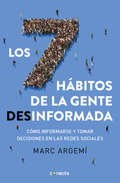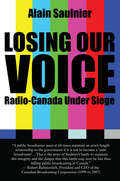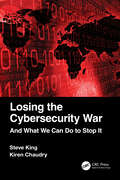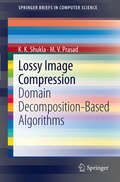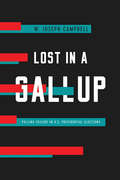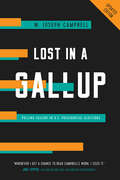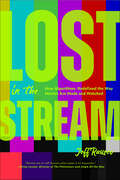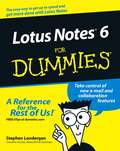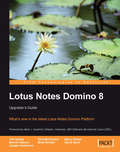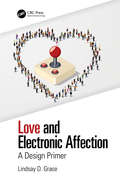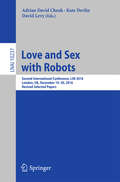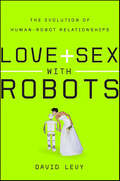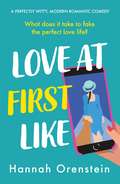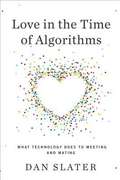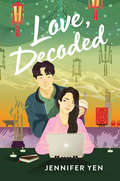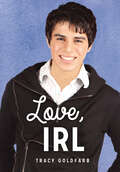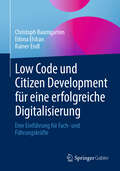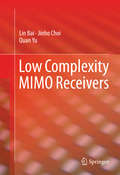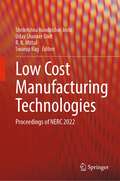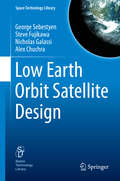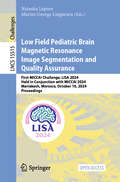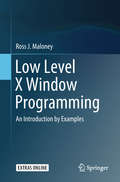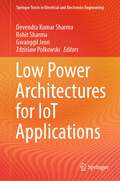- Table View
- List View
Los siete hábitos de la gente desinformada: Cómo informarse y tomar decisiones en las redes sociales
by Marc Argemí BallbéVivimos el espejismo de creer que, como hemos consultado internet, estamos lo suficientemente informados para tomar buenas decisiones. Sin embargo, esta idea es errónea. Este libro permite identificar los hábitos que nos hacen más vulnerables a la desinformación en el entorno digital y ofrece las herramientas para decidir por nosotros mismos tanto en el terreno personal como profesional. Estar bien informado significa contar con suficientes datos para, de entre todas las decisiones posibles, poder elegir una. Sin embargo, la experiencia nos demuestra que muchas decisiones tomadas con seguridad están lejos de sustentarse en los datos, circunstancia que explica que podamos parecer al mismo tiempo unos perfectos ignorantes y muy decididos. Internet y las redes sociales han llevado esta problemática hasta el extremo. Nunca antes habíamos tenido acceso a tanta información, aunque esto no implica que seamos capaces de escoger mejor. Los algoritmos del entorno digital (donde conviven webs, Facebook, Instagram, Twitter o WhatsApp) no siempre están programados para ayudarnos a elegir de forma adecuada. Tenemos la engañosa percepción de que estamos bien informados y, por ello, decidimos correctamente. No obstante, la desinformación nos afecta en nuestra vida personal y profesional. ¿Soy víctima de este fenómeno? La respuesta, con toda probabilidad, sería afirmativa porque nos desinformamos con facilidad y de modos muy diversos. El objetivo de este libro es ayudar a identificar los hábitos que nos hacen más vulnerables: el cuñadismo, la incredulidad crédula, la indecisión crónica, la ansiedad, el confusionismo relacional, el activismo visceral y la precariedad informativa. Y, con sus herramientas prácticas para contrarrestar la desinformación, será de utilidad tanto para los expertos en redes sociales y profesionales de la gestión de cuentas en Twitter como para aquellas personas que solo visitan las páginas web de los periódicos de toda la vida.
Losing Our Voice: Radio-Canada Under Siege
by Alain Saulnier Pauline CoutureThe inside story of decades of government interference in the work of our national public broadcaster, CBC/Radio-Canada. Is there a quiet campaign to hamstring and silence the CBC? In Losing Our Voice Alain Saulnier, long-time head of news and public affairs at Radio-Canada, documents the decades of political interference that have jeopardized the very existence of one of Canada’s most important cultural institutions. For French-speaking Canadians, with limited options in their own language, the national broadcaster is all the more important. But tensions surrounding national unity and identity have exacerbated the tendency of federal politicians to meddle in CBC/Radio-Canada’s content and management. Saulnier takes us behind the scenes as these tensions play out, and culminate in the punitive Harper budget cuts.
Losing the Cybersecurity War: And What We Can Do to Stop It
by Steve KingThis book explains the five pillars or battlefields of cybersecurity and how a Zero Trust approach can change the advantage on each battlefield. We have taken a deep dive into each of five battlefields where we have a decided disadvantage due to constitutional structure and moral behavioral guidelines, where we provide examples of how we got here, what we can do about it, why we got here, and how we can avoid these traps in the future. This is a unique viewpoint that has never been explored – the five battlefields include Economics, Technology, Information, Education, and Leadership – and how each has contributed to our current disadvantage on the global stage. We go on to discuss how Zero Trust can change the game to create an advantage for us going forward. The credibility of Zero Trust stems directly from the father of Zero Trust, John Kindervag, who says, “And now, Steve has written a new book on Zero Trust called Losing the Cybersecurity War: And What We Can Do to Stop It. It is undeniably the best Zero Trust book yet written. While other writers have focused on implementing Zero Trust from their perspectives, Steve focuses on why Zero Trust is so important on the modern cybersecurity battlefield. His concept of the five cyber battlefields is a great insight that will help us win the cyberwar. By weaving Zero Trust principles throughout these five concepts, Steve demonstrates how the ideas and efforts involved in building Zero Trust environments will lead to a profound shift in terrain advantage. No longer will attackers own the high ground. As defenders and protectors, we can leverage modern technology in a Zero Trust way to keep our data and assets safe from infiltration and exploitation.” Steve King is the Managing Director; CyberTheory and Founder/Executive Director, CyberEd.io; cybersecurity Expert certified CISM and CISSP. He has 20 years’ experience in cybersecurity markets as CISO, CEO, and CMO; he is a Cybersecurity Technology Product and Services Sector founder and innovator; Digital Branding and Ad Agency founder, and his clients have included Starbucks, Matson, Abercrombie & Fitch, Harley Davidson, Lucky Brand, United Airlines, and Nike. He is a 3x Cybersecurity Start-up Founder and Exec, he has raised $40 million in VC, and he possesses multiple patents. Kiren Chaudry is the product manager for CyberEd.io, the leading platform for cybersecurity education.
Lossy Image Compression
by K K Shukla M. V. PrasadImage compression is concerned with minimization of the number of information carrying units used to represent an image. Lossy compression techniques incur some loss of information which is usually imperceptible. In return for accepting this distortion, we obtain much higher compression ratios than is possible with lossless compression. Salient features of this book include: four new image compression algorithms and implementation of these algorithms; detailed discussion of fuzzy geometry measures and their application in image compression algorithms; new domain decomposition based algorithms using image quality measures and study of various quality measures for gray scale image compression; compression algorithms for different parallel architectures and evaluation of time complexity for encoding on all architectures; parallel implementation of image compression algorithms on a cluster in Parallel Virtual Machine (PVM) environment.
Lost in a Gallup: Polling Failure in U.S. Presidential Elections
by W. Joseph CampbellA guide to the messy and contentious past of US presidential pre-election polls and why they aren’t as reliable as we think. Donald Trump’s unexpected victory in the 2016 U.S. presidential election brought sweeping criticism of election polls and poll-based statistical forecasts, which had signaled that Hillary Clinton would win the White House. Surprise ran deep in 2016, but it was not unprecedented. Lost in a Gallup examines in lively and engaging fashion the history of polling flops, epic upsets, unforeseen landslides, and exit poll fiascoes in American presidential elections. Drawing on archival collections and contemporaneous sources, W. Joseph Campbell presents insights on notable pollsters of the past, including George Gallup, Elmo Roper, Archibald Crossley, Warren Mitofsky, and Louis Harris.The story is one of media failure, too, as journalists invariably take their lead from polls in crafting campaign narratives. Lost in a Gallup describes how numerous prominent journalists—including Edward R. Murrow, Jimmy Breslin, Mike Royko, Christopher Hitchens, and Haynes Johnson—were outspoken poll-bashers and critics. In assessing polling’s messy, uneven, and controversial past, Campbell emphasizes that although election polls are not always wrong, their inherent drawbacks invite skepticism and wariness. Readers will come away better prepared to weigh the efficacy and value of pre-election polls in presidential races, the most important of all American elections.
Lost in a Gallup: Polling Failure in U.S. Presidential Elections
by W. Joseph CampbellThis update of a lively, first-of-its-kind study of polling misfires and fiascoes in U.S. presidential campaigns takes up pollsters’ failure over the decades to offer accurate assessments of the most important of American elections.Lost in a Gallup tells the story of polling flops and failures in presidential elections since 1936. Polls do go bad, as outcomes in 2020, 2016, 2012, 2004, and 2000 all remind us. This updated edition includes a new chapter and conclusion that address the 2020 polling surprise and considers whether polls will get it right in 2024. As author W. Joseph Campbell discusses, polling misfires in presidential elections are not all alike. Pollsters have anticipated tight elections when landslides have occurred. They have pointed to the wrong winner in closer elections. Misleading state polls have thrown off expected national outcomes. Polling failure also can lead to media error. Journalists covering presidential races invariably take their lead from polls. When polls go bad, media narratives can be off-target as well. Lost in a Gallup encourages readers to treat election polls with healthy skepticism, recognizing that they could be wrong.
Lost in the Shell: Mind, Body, Identity and the Technology of Information
by Andrea MontiWhat happens to law when the human body becomes replicable, the mind readable, and identity programmable?This book investigates how artificial intelligence, neurotechnology, and synthetic biology are dismantling the legal foundations of personhood. From biometric doubles and cognitive extraction to bodyoids – human bodies grown without consciousness – the author reveals how legal categories struggle to keep pace with technological realities.Blending legal theory, philosophy, and science, the book exposes a profound crisis: law no longer knows what a 'person' is. This timely and provocative work is essential for scholars in law, bioethics, and technology studies seeking to understand how the post-human era challenges the very structure of the legal order. The future is no longer science fiction. It is a legal vacuum.The book will be of interest to scholars and researchers of law, public policy, AI, and ethics. It will also be a handy guide for practicing lawyers.
Lost in the Stream: How Algorithms Redefined the Way Movies Are Made and Watched
by Jeff RauseoExplore Cinema History, Stream Your FavoritesThis engaging book by Jeff Rauseo blends film history with a modern guide to streaming, helping you navigate the complex history of movie making and ultimately how to know what to watch in the vast ocean of content. From the golden age of Hollywood to the best new movies to stream, Rauseo breaks down the ever-evolving movie watching experience to help us understand the good, the bad, and the ugly of streaming.Ever feel overwhelmed by endless streaming choices? Jeff Rauseo&’s Lost in the Stream is your ultimate roadmap, combining movie history insights with an in-depth breakdown of how streaming influences the movies that are made and the ones that we are shown. Whether you&’re searching for the best new movies to stream, hidden Amazon Prime movies, or fun movies to watch on Netflix, this book has you covered. Blending nostalgia with today&’s streaming hits, Lost in the Stream dives deep into the iconic history of film that shaped the art while helping you discover new favorites. It&’s the perfect companion for movie buffs and casual viewers alike. Inside, you'll find: A breakdown of the evolution of film watching, from drive-ins to Blockbuster nights and beyond Engaging insights into the impact finances and algorithms have on the movies that are made A guide to discovering the best films for you Never Wonder What to Watch Again.If you liked The New York Times Book of Movies, The Science of Interstellar, or Oscar Wars, you&’ll love Lost in the Stream.
Lotus Notes 6 For Dummies
by Stephen R. LonderganLotus Notes For Dummies helps readers navigate and employ Lotus Notes to improve productivity and efficiency.Covers the enhanced features of the new version of Lotus Notes including the welcome page, instant messaging, document sharing, calendaring, group scheduling, and going mobile.This is an introductory level book that provides the essential information needed to enable users to get the most from the latest release of Lotus Notes.
Lotus Notes Domino 8: Upgrader's Guide
by Barry Rosen Bennie GibsonThis book walks through the new features in the Lotus Notes/Domino 8 suite and documents these features in a technical, descriptive way, rather than presenting tutorials and examples. The book also talks about likely problems that the user might face while upgrading, and shows how to get the most of the exciting new features. This book walks through the new features in the Lotus Notes/Domino 8 suite and documents these features in a technical, descriptive way, rather than presenting tutorials and examples. The book also talks about likely problems that the user might face while upgrading, and shows how to get the most of the exciting new features.
Love and Electronic Affection: A Design Primer
by Lindsay D. GraceLove and Electronic Affection: A Design Primer brings together thought leadership in romance and affection games to explain the past, present, and possible future of affection play in games. The authors apply a combination of game analysis and design experience in affection play for both digital and analog games. The research and recommendations are intersectional in nature, considering how love and affection in games is a product of both player and designer age, race, class, gender, and more. The book combines game studies with game design to offer a foundation for incorporating affection into playable experiences. The text is organized into two sections. The first section covers the patterns and practice of love and affection in games, explaining the patterns and practice. The second section offers case studies from which designers can learn through example. Love and Electronic Affection: A Design Primer is a resource for exploring how digital relationships are offered and how to convey emotion and depth in a variety of virtual worlds. This book provides: • A catalog of existing digital and analog games for which love and affection are a primary or secondary focus. • A catalog of the uses of affection in games, to add depth and investment in both human-computer and player-to-player engagement. • Perspective on affection game analyses and design, using case studies that consider the relationship of culture and affection as portrayed in games from large scale studios to single author independent games. • Analysis and design recommendations for incorporating affection in games beyond romance, toward parental love, affection between friends, and other relationships. • Analysis of the moral and philosophical considerations for historical and planned development of love and affection in human–computer interaction. • An intersectionality informed set of scholarly perspectives from the Americas, Eurasia, and Oceania. Editor Bio: Lindsay D. Grace is Knight Chair of Interactive Media and an Associate Professor at the University of Miami School of Communication. He is Vice President for the Higher Education Video Game Alliance and the 2019 recipient of the Games for Change Vanguard award. Lindsay is author of Doing Things with Games, Social Impact through Design and more than fifty peer-reviewed papers on games and related research. He has given talks at the Game Developers Conference, SXSW, Games for Change Festival, the Online News Association, the Society for News Design, and many other industry events. He was the founding director of the American University Game Lab and Studio and the designer-developer behind several award winning games, including two affection games. He served as Vice President and on the board of directors for the Global Game Jam™ non-profit between 2014 and 2019. From 2009 to 2013 he was the Armstrong Professor at Miami University’s School of Art. Lindsay also served on the board for the Digital Games Research Association (DiGRA) between 2013 and 2015.
Love and Sex with Robots
by David Levy Adrian David Cheok Kate DevlinLove, marriage, and sex with robots? Not in a million years? Maybe a whole lot sooner! A leading expert in artificial intelligence, David Levy argues that the entities we once deemed cold and mechanical will soon become the objects of real companionship and human desire. He shows how automata have evolved and how human interactions with technology have changed over the years. Levy explores many aspects of human relationships—the reasons we fall in love, why we form emotional attachments to animals and virtual pets, and why these same attachments could extend to love for robots. Levy also examines how society's ideas about what constitutes normal sex have changed—and will continue to change—as sexual technology becomes increasingly sophisticated. Shocking, eye-opening, provocative, and utterly convincing, Love and Sex with Robots is compelling reading for anyone with an open mind.
Love and Sex with Robots: The Evolution of Human-Robot Relationships (Lecture Notes In Computer Science Ser. #10237)
by David LevyLove, marriage, and sex with robots? Not in a million years? Maybe a whole lot sooner!A leading expert in artificial intelligence, David Levy argues that the entities we once deemed cold and mechanical will soon become the objects of real companionship and human desire. He shows how automata have evolved and how human interactions with technology have changed over the years. Levy explores many aspects of human relationships—the reasons we fall in love, why we form emotional attachments to animals and virtual pets, and why these same attachments could extend to love for robots. Levy also examines how society's ideas about what constitutes normal sex have changed—and will continue to change—as sexual technology becomes increasingly sophisticated. Shocking, eye-opening, provocative, and utterly convincing, Love and Sex with Robots is compelling reading for anyone with an open mind.
Love at First Like: A wise and witty rom-com of love in the digital age
by Hannah OrensteinIf you love Jo Watson, Zara Stoneley and Sophie Ranald, you'll LOVE Hannah Orenstein!'A good read for the holidays (or lockdown)' 5* reader review*Includes a special preview of Head Over Heels, Hannah's glorious new rom-com that will make you CHEER!*Love at First Like is the perfect rom-com for anyone who's ever looked for love online!'Such a perfect book for this digital age' 5* reader review'The perfect vacation read!' 5* reader review'I inhaled this book' 5* reader reviewWHAT DOES IT TAKE TO FAKE THE PERFECT LOVE LIFE?Eliza Roth and her sister Sophie co-own a jewelry shop in Brooklyn. One night, after learning of an ex's engagement, Eliza accidentally posts a photo of herself wearing a diamond ring on that finger to her Instagram account beloved by 100,000 followers. Sales skyrocket, press rolls in, and Eliza learns that her personal life is good for business. So she has a choice: continue the ruse or clear up the misunderstanding. With mounting financial pressure, Eliza sets off to find a fake fiancé.Fellow entrepreneur Blake seems like the perfect match on paper, and in real life he shows promise too - if only Eliza didn't feel also drawn to someone else. But Blake doesn't know Eliza is 'engaged'; Sophie asks Eliza for an impossible sum of money; and Eliza's lies start to spiral out of control. Now she can either stay engaged online - or fall in love in real life.Written with singular charm and style, Love at First Like is for anyone growing up and settling down in the digital age.'This glittering gem of a novel is a wise and witty take on family, ambition, and modern love' Andrea Dunlop, author of We Came to Forget
Love in the Time of Algorithms
by Dan Slater“If online dating can blunt the emotional pain of separation, if adults can afford to be increasingly demanding about what they want from a relationship, the effect of online dating seems positive. But what if it’s also the case that the prospect of finding an ever more compatible mate with the click of a mouse means a future of relationship instability, a paradox of choice that keeps us chasing the illusive bunny around the dating track?” It’s the mother of all search problems: how to find a spouse, a mate, a date. The escalating marriage age and declining marriage rate mean we’re spending a greater portion of our lives unattached, searching for love well into our thirties and forties. It’s no wonder that a third of America’s 90 million singles are turning to dating Web sites. Once considered the realm of the lonely and desperate, sites like eHarmony, Match, OkCupid, and Plenty of Fish have been embraced by pretty much every demographic. Thanks to the increasingly efficient algorithms that power these sites, dating has been transformed from a daunting transaction based on scarcity to one in which the possibilities are almost endless. Now anyone—young, old, straight, gay, and even married—can search for exactly what they want, connect with more people, and get more information about those people than ever before. As journalist Dan Slater shows, online dating is changing society in more profound ways than we imagine. He explores how these new technologies, by altering our perception of what’s possible, are reconditioning our feelings about commitment and challenging the traditional paradigm of adult life. Like the sexual revolution of the 1960s and ’70s, the digital revolution is forcing us to ask new questions about what constitutes “normal”: Why should we settle for someone who falls short of our expectations if there are thousands of other options just a click away? Can commitment thrive in a world of unlimited choice? Can chemistry really be quantified by math geeks? As one of Slater’s subjects wonders, “What’s the etiquette here?” Blending history, psychology, and interviews with site creators and users, Slater takes readers behind the scenes of a fascinating business. Dating sites capitalize on our quest for love, but how do their creators’ ideas about profits, morality, and the nature of desire shape the virtual worlds they’ve created for us? Should we trust an industry whose revenue model benefits from our avoiding monogamy? Documenting the untold story of the online-dating industry’s rise from ignominy to ubiquity—beginning with its early days as “computer dating” at Harvard in 1965—Slater offers a lively, entertaining, and thought provoking account of how we have, for better and worse, embraced technology in the most intimate aspect of our lives. .
Love in the Time of Algorithms
by Dan Slater"If online dating can blunt the emotional pain of separation, if adults can afford to be increasingly demanding about what they want from a relationship, the effect of online dating seems positive. But what if it's also the case that the prospect of finding an ever more compatible mate with the click of a mouse means a future of relationship instability, a paradox of choice that keeps us chasing the illusive bunny around the dating track?" It's the mother of all search problems: how to find a spouse, a mate, a date. The escalating marriage age and declining marriage rate mean we're spending a greater portion of our lives unattached, searching for love well into our thirties and forties. It's no wonder that a third of America's 90 million singles are turning to dating Web sites. Once considered the realm of the lonely and desperate, sites like eHarmony, Match, OkCupid, and Plenty of Fish have been embraced by pretty much every demographic. Thanks to the increasingly efficient algorithms that power these sites, dating has been transformed from a daunting transaction based on scarcity to one in which the possibilities are almost endless. Now anyone--young, old, straight, gay, and even married--can search for exactly what they want, connect with more people, and get more information about those people than ever before. As journalist Dan Slater shows, online dating is changing society in more profound ways than we imagine. He explores how these new technologies, by altering our perception of what's possible, are reconditioning our feelings about commitment and challenging the traditional paradigm of adult life. Like the sexual revolution of the 1960s and '70s, the digital revolution is forcing us to ask new questions about what constitutes "normal": Why should we settle for someone who falls short of our expectations if there are thousands of other options just a click away? Can commitment thrive in a world of unlimited choice? Can chemistry really be quantified by math geeks? As one of Slater's subjects wonders, "What's the etiquette here?" Blending history, psychology, and interviews with site creators and users, Slater takes readers behind the scenes of a fascinating business. Dating sites capitalize on our quest for love, but how do their creators' ideas about profits, morality, and the nature of desire shape the virtual worlds they've created for us? Should we trust an industry whose revenue model benefits from our avoiding monogamy? Documenting the untold story of the online-dating industry's rise from ignominy to ubiquity--beginning with its early days as "computer dating" at Harvard in 1965--Slater offers a lively, entertaining, and thought provoking account of how we have, for better and worse, embraced technology in the most intimate aspect of our lives.
Love, Decoded
by Jennifer YenA hilarious, heartfelt rom-com about the unexpected consequences of one teen's quest to help her friends find love, perfect for fans of Jenny Han and Jane Austen. <p><p> High school junior Gigi Wong strives to be the best. After all, that’s what everyone expects of her—her parents, friends, and even potential colleges. Thankfully, her best friend, Kyle, is always there to listen with a smile and a delicious bowl of ramen. Still, with her future—and her dreams—on the line, how is she to stand out when her classmates seem so perfect too? Her answer comes in the form of an app writing contest. If Gigi can secure the nomination to represent her school, she has a chance at a prestigious tech internship. That’s sure to get her applications noticed . . . All she needs is a winning entry. <p><p> When transfer student and new friend Etta confides that she’s struggling to fit in, it gives Gigi an idea. What if she takes what she’s learned from shadowing her aunt Rose, a professional matchmaker, to create a fun friend-making app? Perfect! When Gigi's app goes viral at school, she's the center of attention--and a major scandal. She never meant to hurt anyone, let alone Etta and Kyle. Can she save all she worked so hard for and the relationships that mean so much to her?
Love, IRL (Lorimer Real Love)
by Tracy GoldfarbAlex, a Latino transgender teen, is struggling to balance his feelings for a real-life crush on a Jewish boy in his class and the relationship he has with a boy he knows online—only to find that the two were the same all along. Although not explicit, important issues youth face surrounding online chat rooms, social media, and sexting are brought to light in this refreshing take on an LGTBQ+ relationship. Themes of secret identities and love letters together in a modern LGBTQ+ romance for the digital age make this an exciting and relevant read for teens. Distributed in the U.S by Lerner Publishing Group
Low Code und Citizen Development für eine erfolgreiche Digitalisierung: Eine Einführung für Fach- und Führungskräfte
by Christoph Baumgarten Edona Elshan Rainer EndlAn Ideen für digitalgestützte Innovationen mangelt es in Unternehmen selten. Und doch kommt die Digitalisierung häufig nicht voran: Für disruptive Geschäftsmodelle oder neuartige Geschäftsprozesse sind innovative Ansätze in der Softwareentwicklung erforderlich. Oft stehen Organisationen vor der Herausforderung, mit begrenzten IT-Kapazitäten individuelle Lösungen zügig und ökonomisch zu entwickeln. Der hier vorgestellte Low-Code-Ansatz weist einen Weg aus diesem Dilemma: Er stellt Methoden und Werkzeuge zur Verfügung, die auch Nicht-Informatiker*innen die Entwicklung professioneller Software erlauben. Das Buch bietet einen umfassenden Überblick über Low-Code-Technologien, stellt das für ein Low-Code-getriebenes Citizen Development benötigte Basiswissen bereit und leitet an, wie Citizen Development in Unternehmen etabliert und gesteuert wird. Es zeigt Fach- und Führungskräften neue Wege auf, ungenutztes Potenzial für die digitale Transformation freizusetzen.
Low Complexity MIMO Receivers
by Lin Bai Jinho Choi Quan YuMultiple-input multiple-output (MIMO) systems can increase the spectral efficiency in wireless communications. However, the interference becomes the major drawback that leads to high computational complexity at both transmitter and receiver. In particular, the complexity of MIMO receivers can be prohibitively high. As an efficient mathematical tool to devise low complexity approaches that mitigate the interference in MIMO systems, lattice reduction (LR) has been widely studied and employed over the last decade. The co-authors of this book are world's leading experts on MIMO receivers, and here they share the key findings of their research over years. They detail a range of key techniques for receiver design as multiple transmitted and received signals are available. The authors first introduce the principle of signal detection and the LR in mathematical aspects. They then move on to discuss the use of LR in low complexity MIMO receiver design with respect to different aspects, including uncoded MIMO detection, MIMO iterative receivers, receivers in multiuser scenarios, and multicell MIMO systems.
Low Cost Manufacturing Technologies: Proceedings of NERC 2022
by Uday Shanker Dixit Swarup Bag Shrikrishna Nandkishor Joshi R. K. MittalThis book is on various advanced, simple, and novel techniques being used and developed in the area of manufacturing processes. Manufacturing sector is one of the important areas which help to improve the economy of our nation. It not only generates employment opportunities but also makes us self-reliant (aatma nirbhar). In line with this important agenda of Government of India, this track envisages high-quality research contributions in the field of low-cost manufacturing technologies. It comprises the research and development studies on the various factors that influence the cost of manufacturing of product or system. The factors are materials, manufacturing processes, material handling processes, skilled manpower, quality control technologies, effective communication, and use of artificial intelligence techniques. The papers are on both numerical and experimental research works related to these aspects.
Low Earth Orbit Satellite Design
by George Sebestyen Steve Fujikawa Nicholas Galassi Alex ChuchraIn recent decades, the number of satellites being built and launched into Earth’s orbit has grown immensely, alongside the field of space engineering itself. This book offers an in-depth guide to engineers and professionals seeking to understand the technologies behind Low Earth Orbit satellites.With access to special spreadsheets that provide the key equations and relationships needed for mastering spacecraft design, this book gives the growing crop of space engineers and professionals the tools and resources they need to prepare their own LEO satellite designs, which is especially useful for designers of small satellites such as those launched by universities. Each chapter breaks down the various mathematics and principles underlying current spacecraft software and hardware designs.
Low Field Pediatric Brain Magnetic Resonance Image Segmentation and Quality Assurance: First MICCAI Challenge, LISA 2024, Held in Conjunction with MICCAI 2024, Marrakesh, Morocco, October 10, 2024, Proceedings (Lecture Notes in Computer Science #15515)
by Marius George Linguraru Natasha LeporeThis open access LNCS volume 15515 constitutes the refereed proceedings of the First MICCAI Challenge on Low Field Pediatric Brain Magnetic Resonance Image Segmentation and Quality Assurance, LISA 2024, Held in Conjunction with MICCAI 2024, in Marrakesh, Morocco, in October 2024. The 6 full papers presented were carefully reviewed and selected from 8 submissions. This MICCAI Challenge focuses on the development and evaluation of automatic image analysis and machine learning algorithms and Ultra-low-field brain imaging has the potential to become a transformative tool for both clinical and research applications.
Low Level X Window Programming: An Introduction By Examples
by Ross J. MaloneyThis is the missing X Window book. While others have shown what the X Window system has available, this book shows how to convert this potential into working tools to fulfil your visualisation needs. It is of the show-me class of books. The majority of the book covers Xlib, although a short coverage of Xcb is also given. Included are: . The relationship between Xlib and the X Window protocol; . All the basic Xlib topics are covered; . Complete working programs with their results; . Exercises to reinforce the material just covered. A 9 part partition to building a complete X program is used throughout. This partitioning fosters the inclusion of all code necessary. All programs are written in C and are one to four pages in length. Open source programs with the occasional Postscript script are shown to provide support as needed. Throughout the examples consideration is given to using colour. The examples produce simple results with the aim of providing building blocks for application oriented codes. The book is directed at graduate students and researchers who create computer code to visualise their data.
Low Power Architectures for IoT Applications (Springer Tracts in Electrical and Electronics Engineering)
by Rohit Sharma Zdzislaw Polkowski Devendra Kumar Sharma Gwanggil JeonThis book provides comprehensive coverage of different aspects of low-power circuit synthesis for IoT applications at various levels of the design hierarchy, starting from the layout level to the system level. For a seamless understanding of the subject, the basics of MOS circuits have been introduced at the transistor, gate and circuit level, followed by various low-power design methodologies, such as supply voltage scaling, switched capacitance minimization techniques, and leakage power minimization approaches. The contents of this book are useful to students, researchers, as well as practicing engineers. Low-power architectures refer to the latest development in computer microchips which are created by integrating hundreds of thousands of transistors on one chip for different IoT applications. Emerging research in this area has the potential to uncover further applications for IoT in addition to system advancements.
